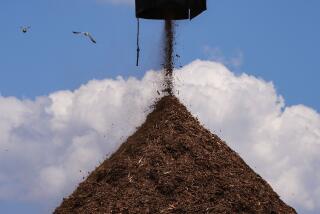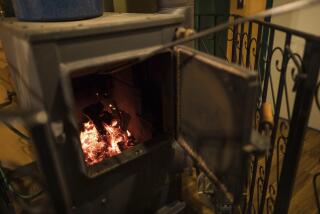High oil prices sparking wood sales
- Share via
More American households, faced with an 83% increase in heating-oil prices over the last year, are turning to an alternative as old as the Stone Age: wood.
Although the typical wood stove emits as much as 350 times more pollution than an oil furnace, according to the Environmental Protection Agency, some homeowners find the economics compelling. Firewood costs less than half as much as heating oil in terms of energy produced, according to the Energy Department and FirewoodCenter.com.
“I got nearly a $2,500-a-year saving by putting in a wood boiler,” says Wendy Wells, 39, a New Hampshire bookkeeper who replaced her oil furnace two years ago with a $3,700 wood-oil combination.
Sales of wood-pellet stoves, the least environmentally harmful wood-heating devices, more than tripled since 1999 to 133,105 last year, according to the Hearth, Patio & Barbecue Assn. in Arlington, Va. At Thayer Nursery in Milton, Mass., owner Josh Oldfield says firewood sales are 15% to 18% higher than a year earlier.
“As oil creeps up toward $100 a barrel, firewood sales have increased dramatically,” Oldfield says.
Business also has picked up for sellers of wood stoves, boilers and ovens used to dry wood, or kilns, says Sherri Latulip, co-owner of Mountain Firewood Kilns in Littleton, N.H. Sales have tripled, says her husband, Bill. Mountain Firewood’s kilns retail for $21,800, and combination wood-oil boilers go for as much as $6,490.
“When people hear oil is going to get expensive, they start buying,” he says.
Ray Colton, owner of Colton Enterprises Inc. in Pittsfield, Vt., says he sells kiln-dried firewood for $220 a cord, the same as last year. A cord, 128 cubic feet of stacked firewood, is about equal to the amount that can be loaded onto two full-sized pick-up trucks. The national average is about $160 a cord, according to FirewoodCenter.com.
Wood was the primary heating source for about 1.3% of U.S. households in 2005, according to the most recent Energy Department data. That was down from 7.1% 20 years earlier. Seven percent of homes use heating oil, 58% natural gas and 30% electricity. Propane and other fuels account for the remainder.
Pollution is the big drawback. Even stoves that burn dog-food-sized pellets of compressed sawdust emit about 40 times more particulate matter, similar to soot, than an oil furnace, according to the EPA.
The emissions can contribute to respiratory illnesses such as asthma, says David Wright, a supervisor with Maine’s Department of Environmental Protection. Wood burning for residential heating accounted for 57% of toxic air emissions in the state, he says.
The EPA issued regulations for wood stoves in 1989, mandating that they emit no more than 4.1 grams of smoke an hour for catalytic stoves, which convert particulates and harmful gases into less-polluting exhaust, and 7.5 grams an hour for ordinary stoves. Manufacturers that fail to meet those standards may be fined as much as $100 a stove, says John Dupree, supervisor of the EPA’s wood heater program.
New Jersey has a law that forbids use of outdoor wood boilers that emit smoke, says Lisa Rector, senior policy analyst for the Northeast States for Coordinated Air Use Management, a nonprofit group of state air-quality agencies. States including Connecticut and Vermont have rules that require wood boilers to be placed a given distance from a neighbor’s property.
Wells says air quality isn’t a major concern for people in her part of New Hampshire, where the temperature falls to minus 20 degrees for weeks at a time. Almost everyone burns wood, she says.
“It is very expensive to heat our houses up here because we are so far north and the climate is so cold,” Wells says. “We live among the trees, where the deer and antelope play.”
More to Read
Inside the business of entertainment
The Wide Shot brings you news, analysis and insights on everything from streaming wars to production — and what it all means for the future.
You may occasionally receive promotional content from the Los Angeles Times.










